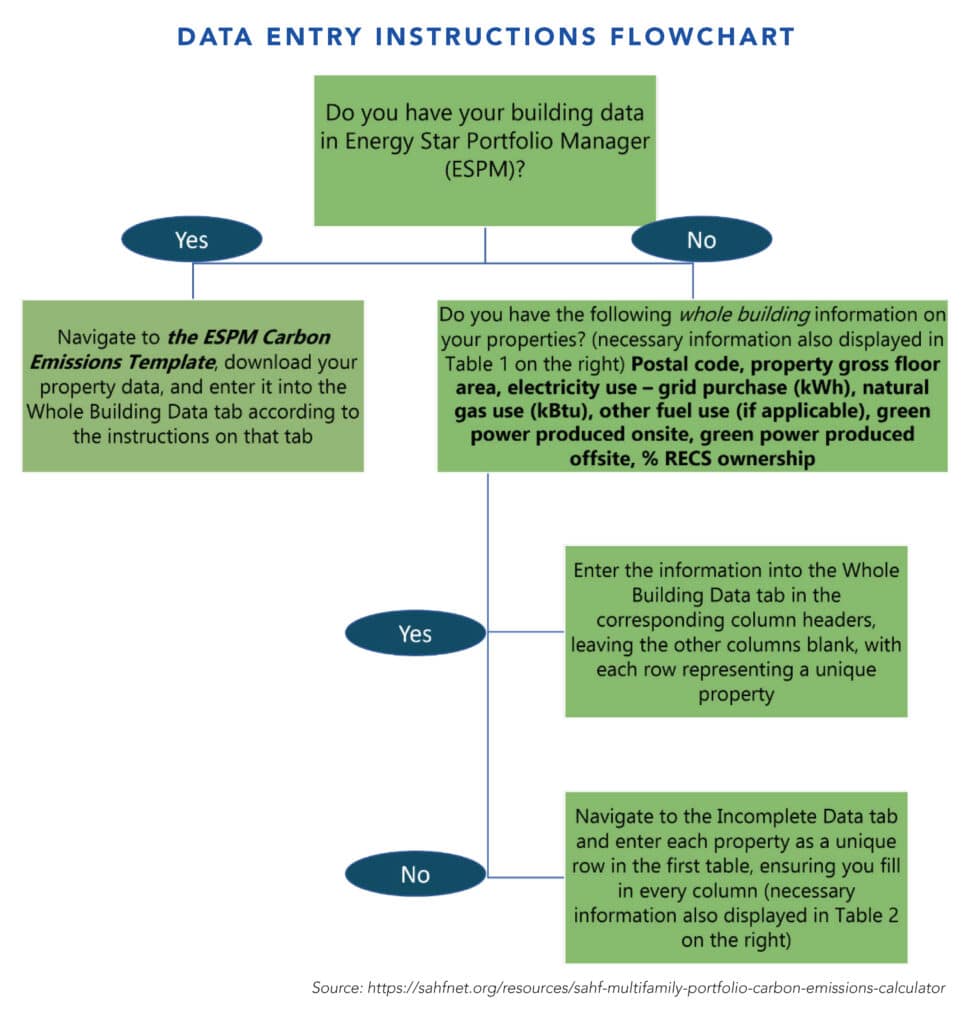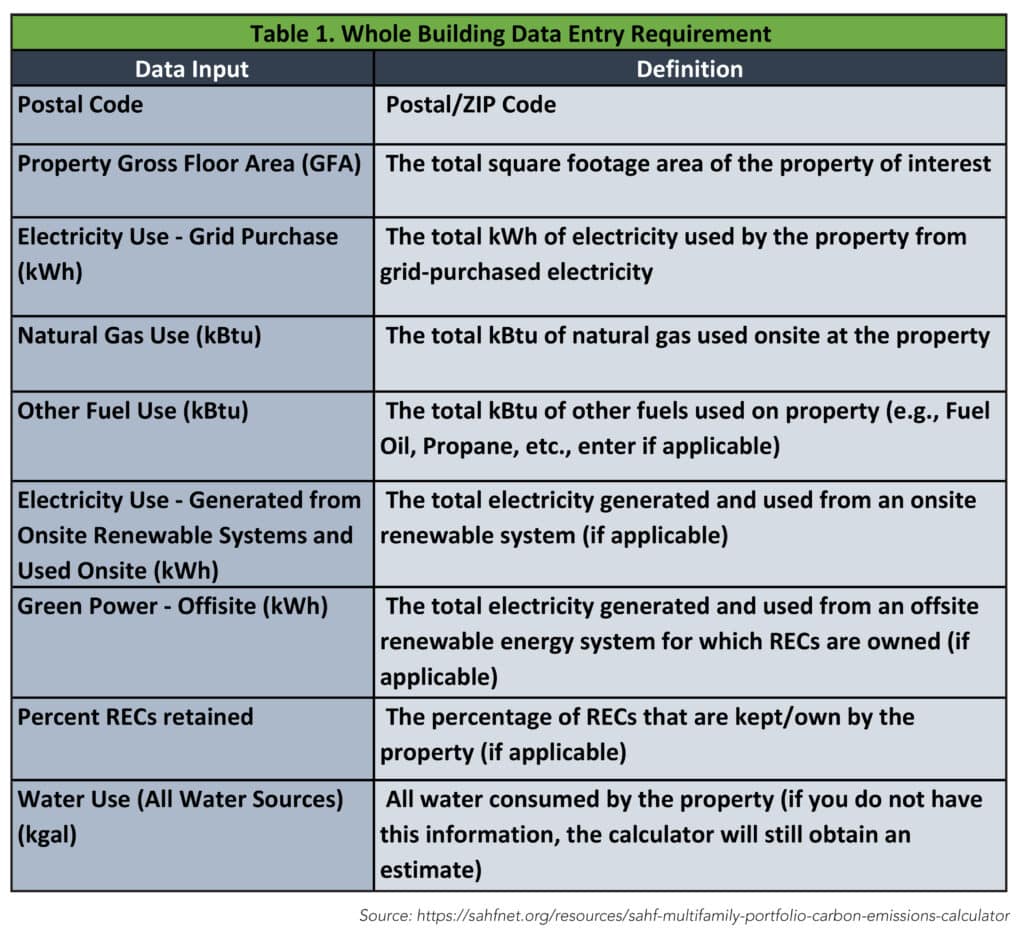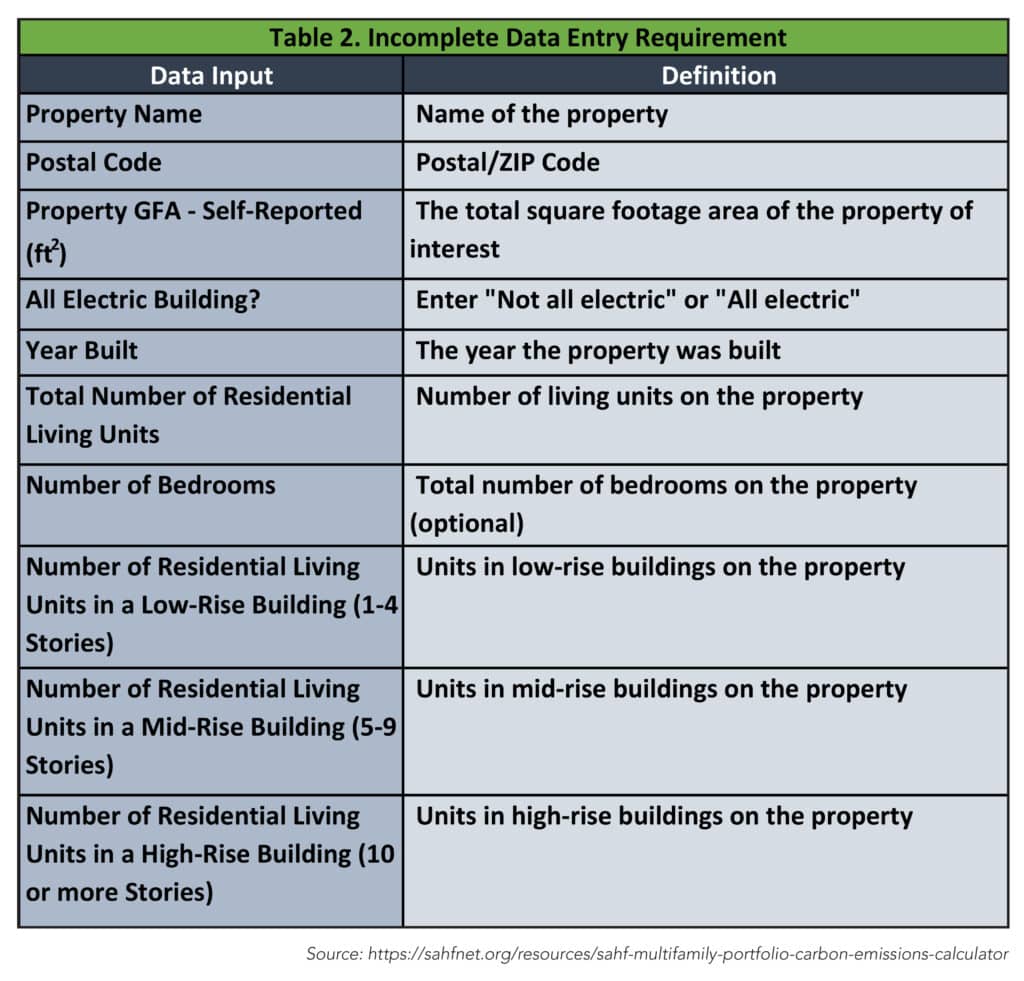Establishing a Baseline

By Nushin Huq
7 min read
SAHF’s Multifamily Portfolio Carbon Emissions Calculator
For multifamily portfolio owners, having greenhouse gas emissions information for their entire portfolio can be more useful than simply building specific information in carbon reduction goal setting. A newly released carbon calculator looks to provide that information, a first step to measurable carbon reductions.
In February, Stewards of Affordable Housing for the Future (SAHF), released a new tool, which calculates portfolio-wide greenhouse gas emissions for multifamily portfolio owners. SAHF’s Multifamily Portfolio Carbon Emissions Calculator is aimed to give owners a tool to calculate the emissions baseline, a first step to reaching low-carbon goals.
The calculator quantifies both direct and indirect—Scope 1 (direct emissions that occur from sources that are owned by an organization, such as fuels combusted on-site at a property) and Scope 2 (indirect emissions associated with the purchase of electricity, steam, heat or cooling)—carbon emissions using property-level energy and water data. It provides annual carbon emissions for 2016 through 2020, allows for the import of Energy Star Portfolio Manager data and aligns with the Department of Energy’s Better Climate Challenge baseline calculation protocols.
“As more local jurisdictions start thinking about voluntary or mandatory building performance standards, whether it’s for energy or carbon, having an understanding of what your portfolio and how your properties are in comparison to what new policies and programs may be coming out is really important,” says Lauren Westmoreland, SAHF’s vice president of energy and sustainability.
SAHF is a collaborative nonprofit consisting of 12 member organizations that are leading nonprofit providers of affordable homes. The organization focuses on policy and practice work in several different areas, including energy and sustainability.
To use the downloadable calculator, portfolio owners will enter whole-building data for their entire portfolio while the calculator uses straightforward calculations to provide information on how much electricity and natural gas they are using and the emissions associated with that. The data and results stay with the user.
Where that data isn’t available, users can apply a baseline, which is based on a collection of buildings across the U.S. where whole-building data is available. This is an important feature of the calculator because of the variability of access to data across the country, Westmoreland says. This often includes the tenant portion of utility bills.
In discussions with SAHF members, Westmoreland says they found there was a strong need to understand the whole portfolio even where users don’t have whole-building data.
“In that case, we needed to find a way to make assumptions,” Westmoreland says. “If you only have data around your common spaces, perhaps electricity for common rooms or computer labs, it’s not really telling you the full picture of what’s happening in that building.”
In those instances where data is unavailable, the calculator gives users an option to substitute their incomplete energy data with a calculator-provided baseline, which is based on a collection of buildings across the U.S. that have location-specific, whole-building data.
For example, for a building in Atlanta, the baseline would be based on southeast properties of a similar size, similar building type and similar fuels being used in that building.
“It’s a way to allow users to understand both their carbon emissions for their properties that have all energy data, but also those that do not, and to be able to easily distinguish between the two at the portfolio level,” Westmoreland says.
The calculator allows users to pull information from the Energy Star Portfolio Manager, a free tool by the Environmental Protection Agency. Energy Star is used by a number of local jurisdictions, as well as the DOE’s Better Buildings Challenge. The Department of Housing and Urban Development is also talking about potentially using the tool for its own benchmarking efforts that will come out through Inflation Reduction Act funding, Westmoreland says. When designing the calculator, the SAHF team found that renewable assets don’t always make it into the Energy Star Portfolio Manager, Westmoreland says. If a user’s renewable asset isn’t in the portfolio manager, they can add it under the renewable tab in the calculator
The Big Reach
The carbon emissions calculator grew out of a previous initiative called “The Big Reach.” In 2013, SAHF made a commitment across its entire member portfolio to reduce energy and water usage by 20 percent by 2020.
“Our members succeeded and actually exceeded that goal, reducing their energy usage by 29 percent and water usage by 24 percent,” Westmoreland says.
Once the Big Reach initiative wrapped up, SAHF started looking toward carbon reduction. The Wells Fargo Foundation awarded organization funding to build the Carbon Emissions Calculator, as well as a soon-to-be-released roadmap, which will assist property owners in prioritizing within their portfolio what they should do to reduce their carbon, Westmoreland says.
Only A First Step
The calculator is only a first step and doesn’t necessarily help owners prioritize actions to reach low-carbon goals. That can be achieved by using a forthcoming tool, called the Roadmap Tool, planned to be released this summer, Westmoreland says.
“I think that they will get the most use out of transferring this information into our Roadmap Tool,” Westmoreland says. “That’s where you can segment your portfolio and start to apply decarbonization strategies to see how much that reduces you down to your goal.”
The calculator tool is used first to set a baseline and second for checking progress on an annual basis. The Roadmap Tool will be used by owners for scenario planning and prioritizing different sections of their portfolio.
SAHF started piloting the roadmap with its members and was able to make the connection quickly between the two tools.
“They were excited to see what they could do with regard to taking the calculator information and translating that into scenario planning,” Westmoreland says.
One SAHF member used the calculator to help them better understand their baseline years for 2016 to 2019 to determine which year they were going to set as their baseline for the DOE’s Better Climate Challenge, Westmoreland says. The program allows participants to go back up to five years in setting a baseline year.
In addition to setting the baseline, they were able to use the tool to help track, on an annual basis, how they are moving in terms of carbon emissions with the processes they already have in place.
When SAHF started piloting the carbon emission calculator with its members, the National Housing Trust (NHT), a SAHF member, was considering joining the DOE’s Better Climate Challenge.
“I think it was really timely,” says Ryan Moya, managing director of sustainability at NHT. “When the calculator was introduced, we were internally working on a similar exercise of goal setting, setting a baseline for the calculator and looking at a list of strategies to achieve the Better Climate Challenge goal.”
NHT ran a year-by-year analysis using the calculator and selected 2018 as its baseline year, Moya says. In 2018, the organization had a little over 30 buildings in which it had either whole ownership or partnered with other affordable housing organizations, mostly in the DC area. Four buildings didn’t have whole-building data, including the tenant data.
“We used the estimate data in the tool,” Moya says. “It proved to be really helpful.”
Going forward, NHT will use the calculator for its climate challenge partnership baseline for some of the assumptions and emissions reductions that are related to achieving the goal, Moya says.
Moya adds that finding emissions factors over a large portfolio or a moving target can be difficult but going through the process and having a tool that can be used internally is helpful for those that aren’t looking at emissions practice on an ongoing basis and it isn’t their scope of work.
“Organizationally, we did find it really helpful,” Moya says.


